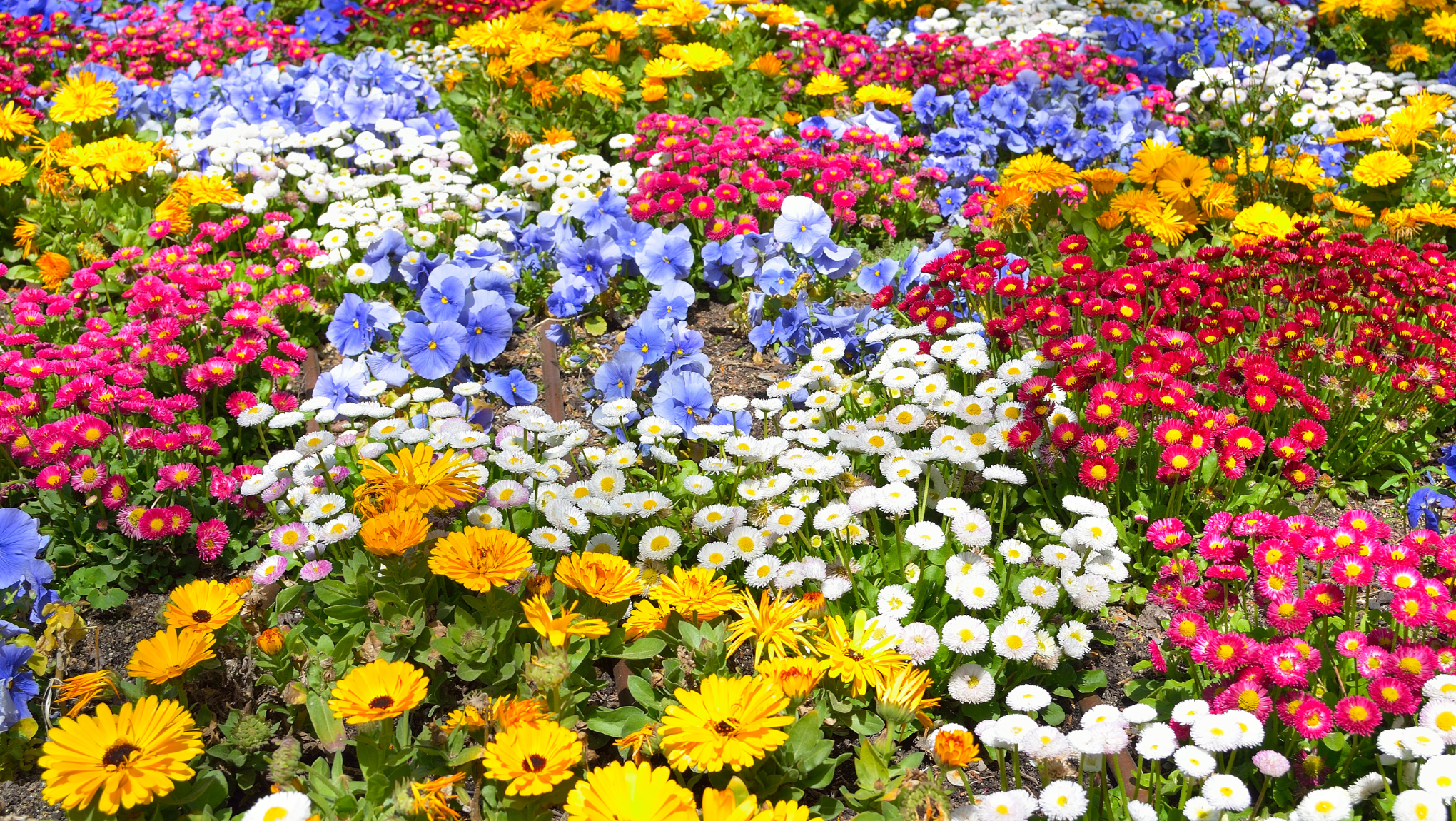India's scorching summer can be challenging for plants, but some flowers thrive in the heat, adding beauty and vibrancy to gardens. Whether you want to attract pollinators, enhance your landscape, or enjoy fresh blooms throughout the season, these ten summer flowers are perfect for Indian climates. Let's explore the best summer flowers to grow in India and how to care for them.
1. Bougainvillea: The Summer Beauty
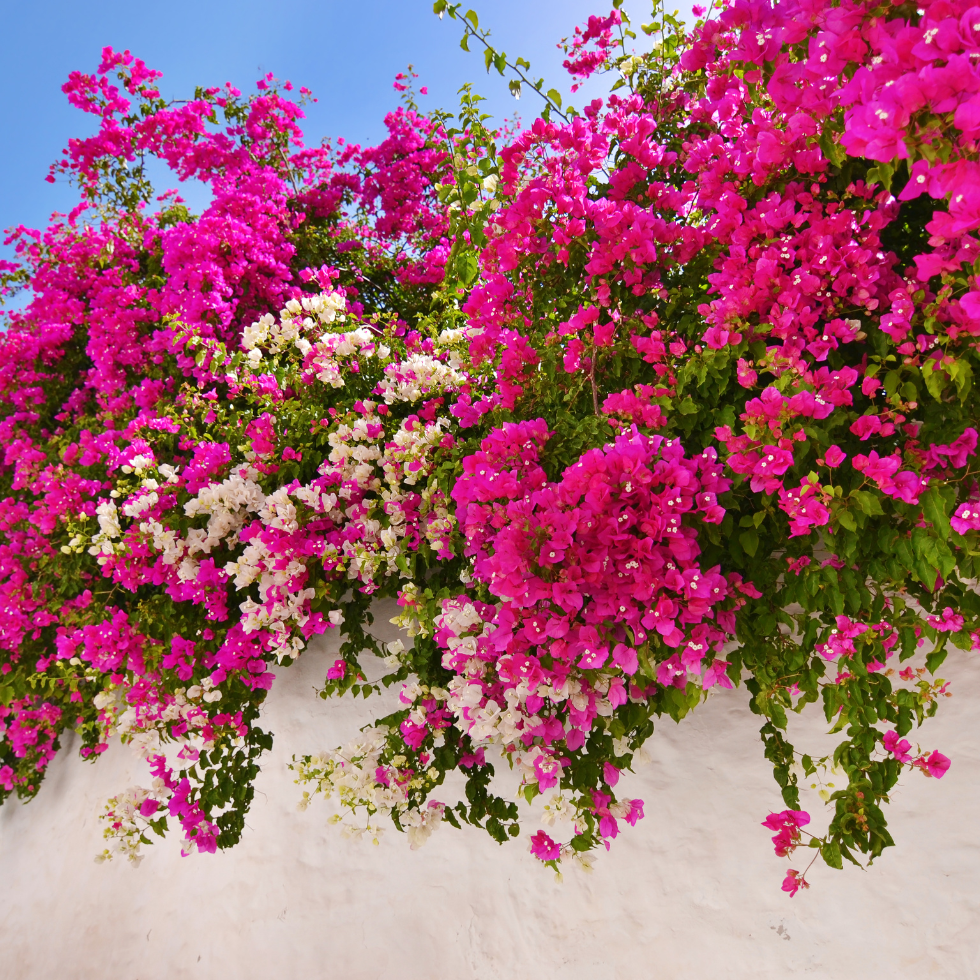
Bougainvillea is a vibrant, drought-tolerant flowering plant that thrives in the scorching Indian summer. Known for its paper-thin, colorful bracts that surround tiny white flowers, this plant creates a breathtaking display of color. The bracts come in shades of pink, magenta, red, orange, white, and even purple, making it a stunning addition to gardens, balconies, and boundary walls. Bougainvillea is a fast-growing climber that can easily cover fences, trellises, and pergolas, providing a natural shade and aesthetic appeal.
This hardy plant is perfect for Indian climates as it thrives in direct sunlight, requires minimal watering, and can withstand high temperatures. Whether you want to add a splash of color to your garden or cover a dull wall, Bougainvillea is a perfect choice.
Why Choose Bougainvillea?
🌞 Thrives in Harsh Sunlight – Perfect for Indian summers, as it loves full sun exposure.
🎨 Comes in Various Colors – Available in multiple vibrant shades to suit your garden’s aesthetics.
💧 Low Maintenance – Doesn’t require frequent watering or fertilization.
🏡 Ideal for Vertical Gardening – Enhances fences, trellises, and boundary walls beautifully.
🌱 Drought-Tolerant – Can survive in dry conditions, making it perfect for regions with water scarcity.
🐝 Attracts Pollinators – Invites butterflies and bees, supporting biodiversity.
Growing Tips for Bougainvillea
✅ Sunlight – Needs at least 5-6 hours of direct sunlight daily for optimal flowering.
✅ Soil – Prefers well-draining, slightly acidic soil. Sandy or loamy soil works best.
✅ Watering – Water sparingly; overwatering can cause root rot. Let the soil dry out between watering.
✅ Fertilization – Use a low-nitrogen fertilizer once a month during the growing season for better blooms.
✅ Pruning – Regularly trim branches after flowering to maintain shape and promote new growth.
✅ Support Structure – If growing as a climber, provide trellises or fences for support.
Benefits of Growing Bougainvillea
✔ Enhances Garden Aesthetics – Its vibrant blooms add a tropical touch to any space.
✔ Provides Natural Shade – Grown over pergolas, it offers a cool and beautiful canopy.
✔ Boosts Air Quality – Acts as a natural air purifier by absorbing toxins.
✔ Drought-Resistant – A perfect option for low-maintenance and water-efficient gardening.
✔ Increases Privacy – Can be used as a colorful hedge to enhance privacy in gardens.
Bring Home the Beauty of Bougainvillea!
Add this stunning summer flower to your garden and enjoy its long-lasting, vibrant blooms! 🌿✨
🌸 Shop Bougainvillea Plants Now!
2. Hibiscus: The Tropical Beauty
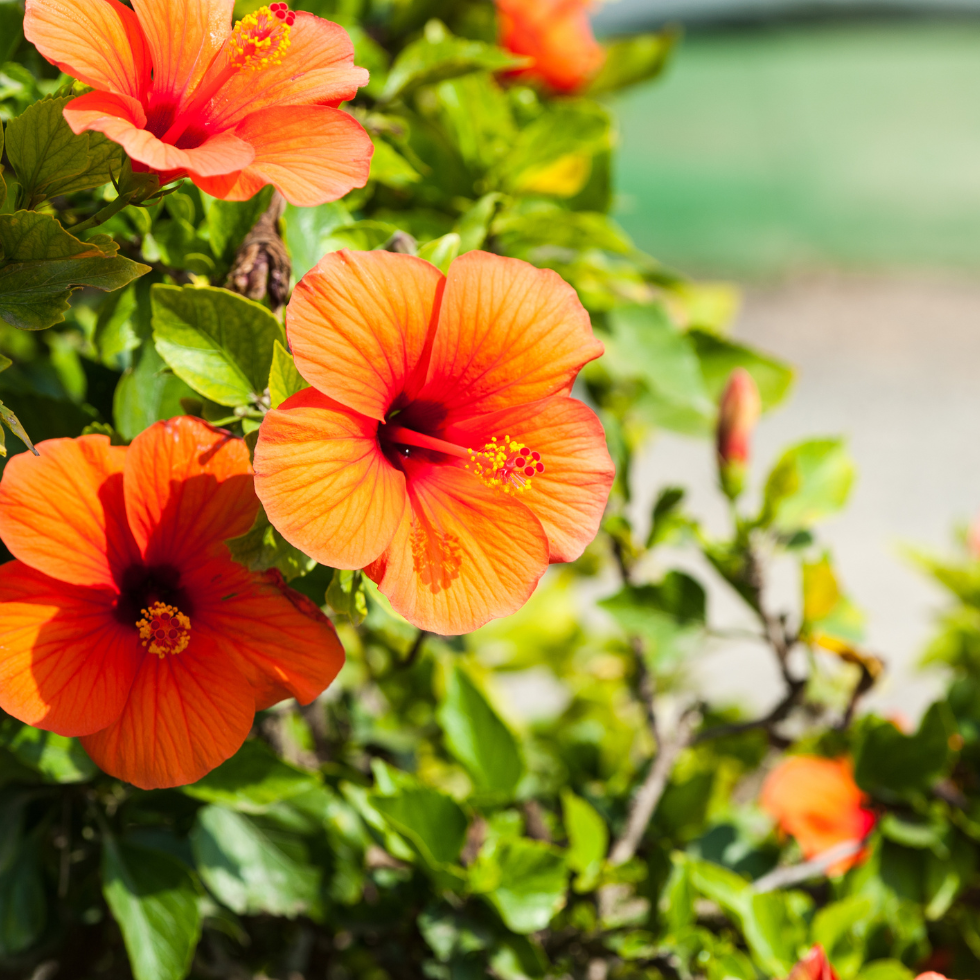
Hibiscus is a stunning tropical flowering plant known for its large, trumpet-shaped blooms and vibrant colors, including red, yellow, pink, orange, and white. It is a sun-loving plant that thrives in India’s hot and humid climate, making it an excellent choice for summer gardens.
Apart from its aesthetic appeal, hibiscus holds great cultural and medicinal significance. It is widely used in Ayurveda for its health benefits and is also offered in religious rituals. The plant is a fast grower, producing flowers almost year-round, with peak blooming in summer. It attracts butterflies, bees, and hummingbirds, making it a great addition to pollinator-friendly gardens.
Hibiscus plants can be grown in pots, gardens, or as hedges, making them versatile and easy to incorporate into any landscape.
Why Choose Hibiscus?
🌞 Loves Full Sun – Flourishes in bright sunlight, making it perfect for Indian summers.
🌺 Blooms Almost Year-Round – Enjoy vibrant flowers across multiple seasons.
🍵 Medicinal Uses – Used in herbal teas, hair care, and skincare remedies.
🏡 Ideal for Pots & Gardens – Grows well in containers, balconies, or directly in the ground.
🐝 Attracts Pollinators – Draws butterflies and bees, promoting a healthy ecosystem.
🛕 Culturally Significant – Used in Hindu rituals and Ayurvedic treatments.
Growing Tips for Hibiscus
✅ Sunlight – Needs at least 6 hours of direct sunlight daily.
✅ Soil – Prefers well-draining, slightly acidic soil enriched with organic matter.
✅ Watering – Requires regular watering but avoid waterlogging. Keep the soil moist but not soggy.
✅ Fertilization – Use a balanced fertilizer rich in phosphorus and potassium every two weeks.
✅ Pruning – Trim dead or weak branches to encourage new growth and more blooms.
✅ Pest Control – Watch out for aphids and mealybugs; use neem oil for organic pest management.
Benefits of Growing Hibiscus
✔ Enhances Garden Beauty – Adds a tropical vibe with its bold, bright flowers.
✔ Boosts Hair & Skin Health – Hibiscus flowers are used in herbal remedies for hair growth and glowing skin.
✔ Supports Biodiversity – Attracts pollinators like bees and butterflies.
✔ Air-Purifying Plant – Helps remove toxins from the air.
✔ Natural Cooling Effect – Provides shade and helps reduce surrounding temperatures.
Add Hibiscus to Your Garden Today!
Bring home this tropical beauty and enjoy its vibrant blooms and multiple benefits! 🌿✨
3. Marigold: The Sun’s Best Friend
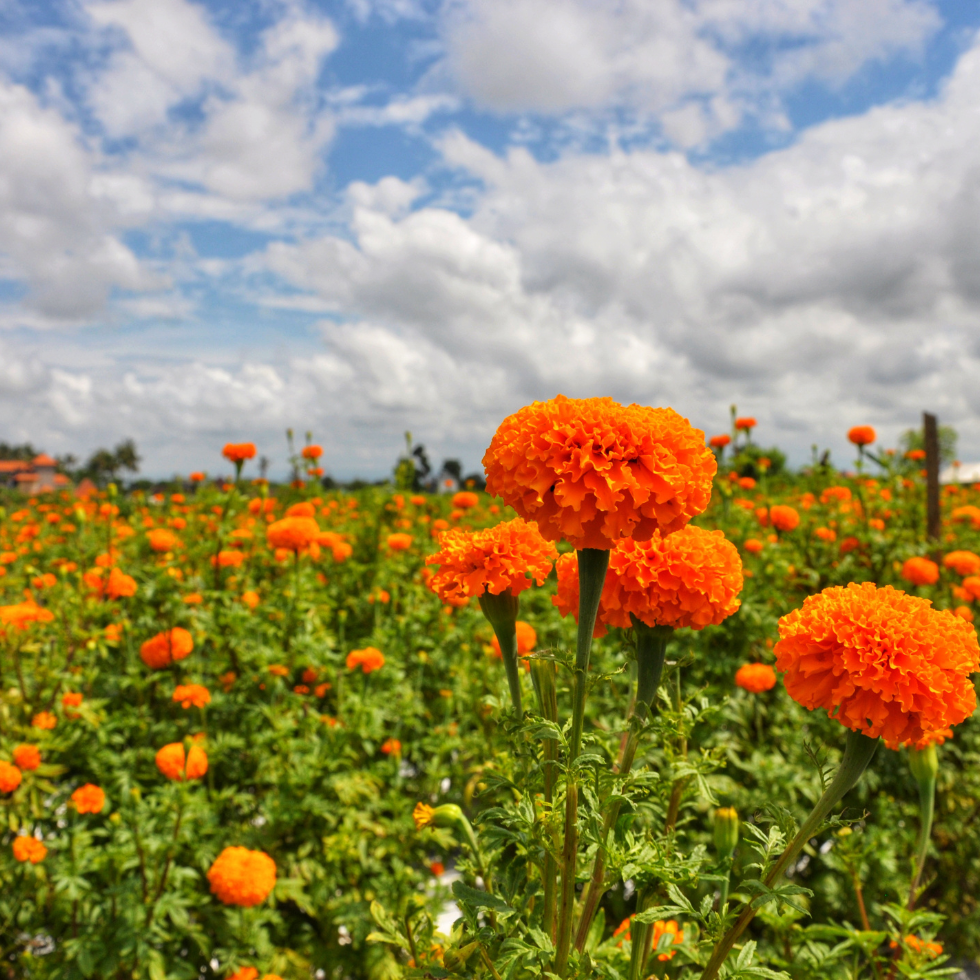
Marigold is one of the most popular and easy-to-grow flowering plants in India. Known for its bright yellow, orange, and golden blooms, marigold thrives in hot and sunny climates, making it a perfect choice for summer gardens. Its cheerful flowers add a festive touch to home gardens, temple decorations, and celebrations, especially during festivals like Diwali and Durga Puja.
Apart from its aesthetic appeal, marigold has pest-repellent properties, making it an excellent companion plant in vegetable gardens. The flowers also have medicinal and skincare benefits, as marigold extracts are used in Ayurvedic and herbal treatments. With minimal maintenance and a long blooming season, marigold is an ideal choice for both beginners and experienced gardeners.
Why Choose Marigold?
☀️ Thrives in Full Sun – Loves hot weather and blooms all summer long.
🌼 Easy to Grow – Low-maintenance plant perfect for beginners.
🌿 Natural Pest Repellent – Helps keep mosquitoes and garden pests away.
🏡 Versatile Use – Ideal for gardens, balconies, pots, and as borders.
🎉 Perfect for Festive Decor – Widely used in Indian rituals and celebrations.
🐝 Attracts Pollinators – Supports bees and butterflies in your garden.
Growing Tips for Marigold
✅ Sunlight – Requires 6-8 hours of direct sunlight daily.
✅ Soil – Prefers well-draining, sandy, or loamy soil with good organic matter.
✅ Watering – Moderate watering; avoid waterlogging. Let the soil dry slightly between watering.
✅ Fertilization – Apply compost or a balanced fertilizer once a month for vibrant blooms.
✅ Pruning – Deadhead (remove spent flowers) regularly to promote continuous flowering.
✅ Pest Control – Naturally repels nematodes and aphids but can attract spider mites; use neem spray if needed.
Benefits of Growing Marigold
✔ Brightens Your Garden – Adds a cheerful, sunny charm to any space.
✔ Protects Vegetable Crops – Repels harmful pests, improving plant health.
✔ Boosts Skin Health – Marigold extracts are used in Ayurvedic creams for healing wounds and skin infections.
✔ Enhances Festive Decor – Essential for garlands, puja decorations, and celebrations.
✔ Air-Purifying Properties – Helps cleanse indoor and outdoor air.
Bring Home the Sunshine with Marigold!
Add this vibrant, sun-loving flower to your garden and enjoy its beauty all summer! 🌿✨
🌼 Shop Marigold Seeds to Grow Your Own Flowers!
4. Madhukamini (Orange Jasmine)
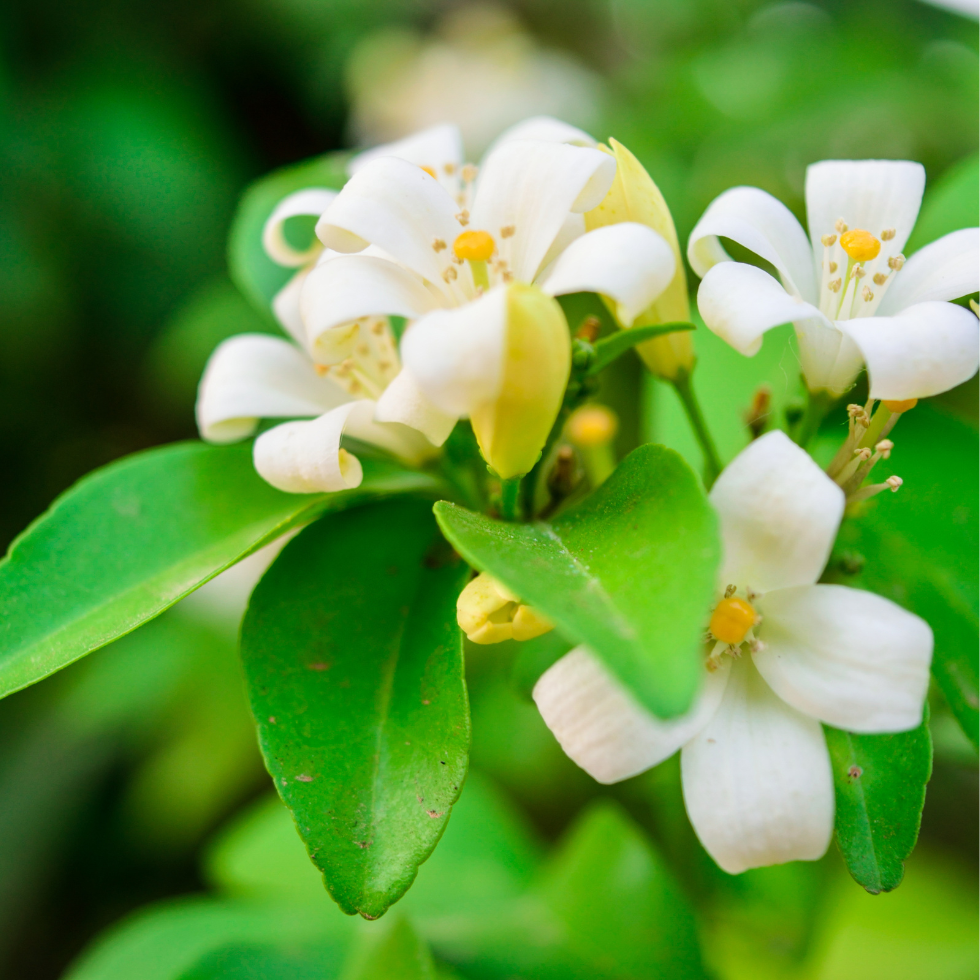
Madhukamini, also known as Orange Jasmine (Murraya paniculata), is a stunning evergreen flowering plant known for its intoxicating fragrance and delicate white blossoms. This tropical beauty thrives in the hot Indian climate and blooms throughout the summer, filling the air with its sweet citrus scent.
The plant features glossy green leaves and clusters of small, star-shaped flowers that resemble miniature jasmine blooms. Despite its name, it is not a true jasmine but belongs to the citrus family. The fragrance of Madhukamini is strongest in the evening, making it a favorite choice for gardens, balconies, and hedges. This plant not only enhances the beauty of your garden but also serves as a natural air freshener.
Why Choose Madhukamini?
🌞 Loves Warm Climates – Thrives in full sun and hot Indian summers.
🌿 Evergreen Shrub – Retains its lush green foliage all year round.
🌼 Heavily Fragrant Flowers – Fills the air with a sweet citrus aroma, especially in the evenings.
🏡 Ideal for Hedges & Borders – Grows well as a natural fence or ornamental shrub.
🐝 Attracts Pollinators – Invites bees and butterflies, supporting garden biodiversity.
🍊 Produces Small Orange-Like Fruits – Birds love these tiny red-orange berries.
Growing Tips for Madhukamini
✅ Sunlight – Requires 5-6 hours of direct sunlight for maximum flowering.
✅ Soil – Prefers well-draining, slightly acidic to neutral soil with good organic content.
✅ Watering – Moderate watering; let the topsoil dry before rewatering. Avoid overwatering.
✅ Fertilization – Use organic compost or a balanced fertilizer every 4-6 weeks for healthy growth.
✅ Pruning – Trim regularly to shape the plant and encourage more blooms.
✅ Pest Control – Generally pest-resistant but watch for aphids or scale insects; use neem oil if needed.
Benefits of Growing Madhukamini
✔ Adds a Natural Fragrance – No need for artificial air fresheners!
✔ Enhances Garden Aesthetics – Glossy green leaves and white flowers create a beautiful contrast.
✔ Improves Air Quality – Filters toxins and enhances oxygen levels in the surroundings.
✔ Perfect for Compact Spaces – Grows well in pots, balconies, and small gardens.
✔ Cultural & Medicinal Value – Used in traditional medicine for its antibacterial properties.
Fill Your Garden with Fragrance!
Bring home the elegance of Madhukamini and enjoy its captivating blooms all summer long! 🌿✨
🌸 Shop Madhukamini Plants Now!
5. Allamanda (Golden Trumpet)
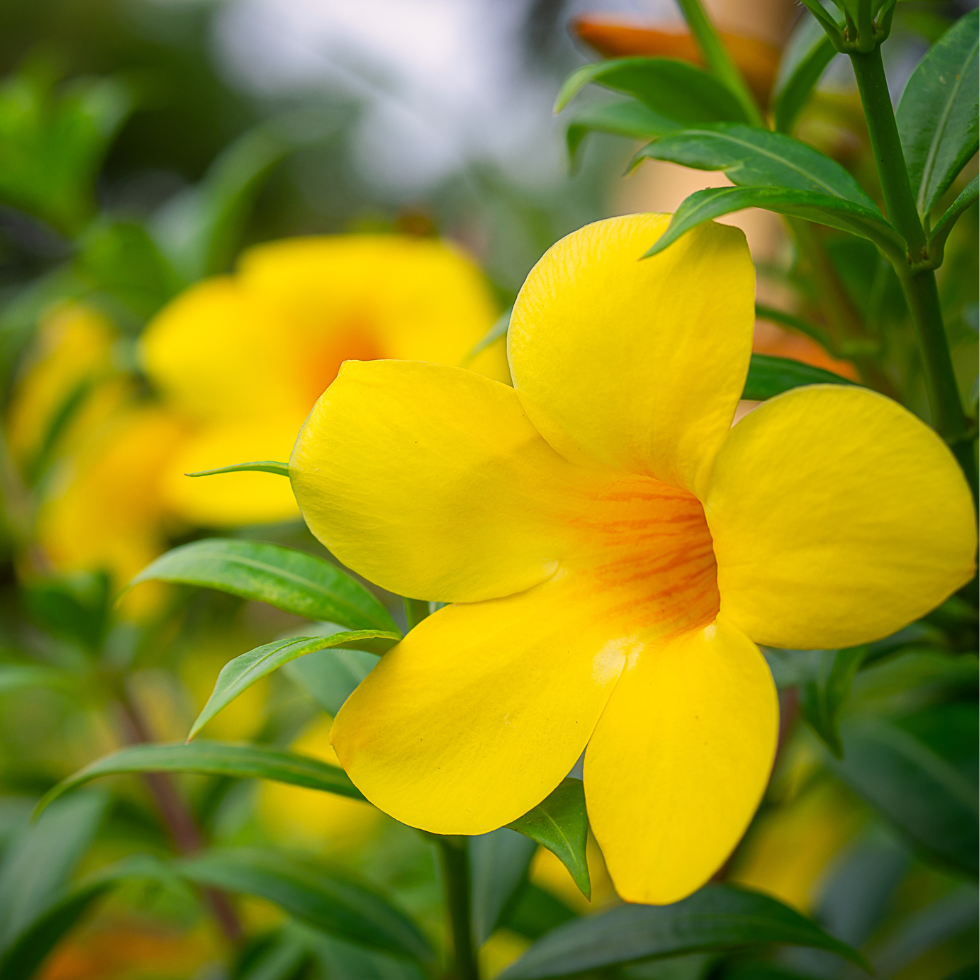
Allamanda, commonly known as the Golden Trumpet, is a fast-growing, evergreen flowering plant that thrives in the warm and humid climate of India. It is famous for its large, trumpet-shaped yellow flowers that bloom profusely throughout summer, making it a stunning addition to any garden.
This plant is a vigorous climber and can be trained over fences, trellises, and arches to create a cascading floral display. The glossy green foliage enhances its beauty, providing a striking contrast to the golden blooms. Allamanda is also known for its natural resistance to pests and diseases, making it a hassle-free choice for gardeners.
Apart from its ornamental appeal, Allamanda has medicinal properties and is used in herbal treatments for skin ailments. However, it is mildly toxic if ingested, so it should be planted with caution in homes with pets or small children.
Why Choose Allamanda?
🌞 Loves Full Sun – Thrives in bright, direct sunlight, perfect for Indian summers.
🌼 Blooms All Summer – Produces vibrant yellow flowers in abundance.
🌿 Fast-Growing Climber – Ideal for vertical gardening, fences, and trellises.
🐝 Attracts Pollinators – Draws butterflies and bees, enhancing biodiversity.
🏡 Low-Maintenance Plant – Drought-tolerant and resistant to most pests.
⚠ Medicinal Uses – Used in herbal remedies but should be handled carefully as it is mildly toxic.
Growing Tips for Allamanda
✅ Sunlight – Requires 6-8 hours of direct sunlight daily.
✅ Soil – Prefers well-draining sandy or loamy soil enriched with organic compost.
✅ Watering – Moderate watering; let the topsoil dry between watering to prevent root rot.
✅ Fertilization – Use a phosphorus-rich fertilizer once a month for maximum flowering.
✅ Pruning – Trim regularly to maintain shape and promote bushy growth.
✅ Pest Control – Naturally resistant to pests but may occasionally attract aphids; use neem oil for organic pest management.
Benefits of Growing Allamanda
✔ Brightens Your Garden – Its golden blooms add a cheerful and tropical touch.
✔ Perfect for Trellises & Arches – A great choice for decorating outdoor spaces.
✔ Air-Purifying Properties – Helps cleanse the air by removing toxins.
✔ Low Water Requirement – Drought-resistant once established.
✔ Creates Natural Shade – Its climbing nature can help cool down pergolas and garden spaces.
Bring Home the Golden Glow!
Add the Golden Trumpet (Allamanda) to your garden for a stunning, sun-loving floral display! 🌿✨
🌼 Shop Allamanda Plants Now!
6. Periwinkle (Vinca)
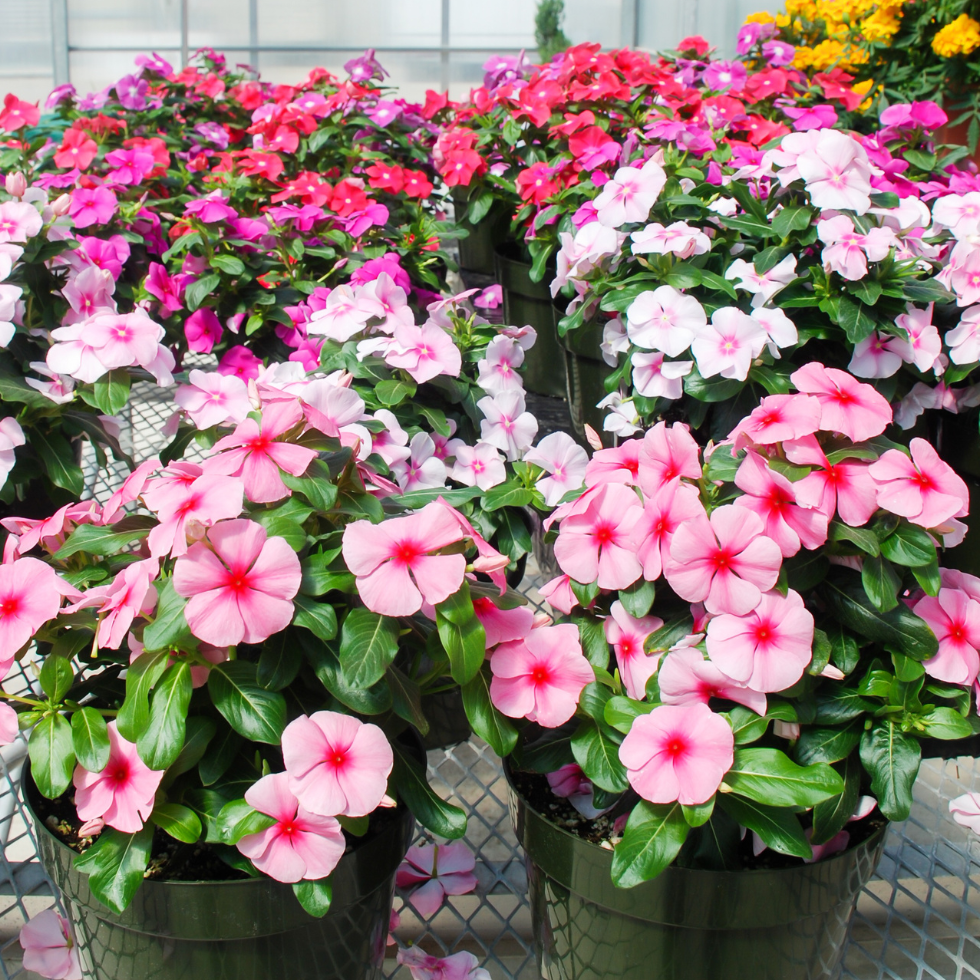
Periwinkle, also known as Vinca or Sadabahar in India, is a hardy, evergreen flowering plant that flourishes even in the hottest summers. This low-maintenance plant produces delicate five-petaled flowers in shades of pink, purple, white, and lavender, creating a carpet of color in gardens, balconies, and landscapes.
One of the most resilient summer flowers, Periwinkle is well-known for its medicinal properties and is widely used in Ayurveda and modern medicine for treating diabetes, cancer, and high blood pressure. It is a perfect ground cover plant, growing effortlessly in garden beds, pots, or even along pathways.
Why Choose Periwinkle?
☀️ Thrives in Harsh Summers – Can withstand extreme heat and drought conditions.
🌸 Blooms Year-Round – A nonstop bloomer that keeps your garden colorful all seasons.
🌿 Low-Maintenance & Fast-Growing – Ideal for beginners and busy gardeners.
🐝 Attracts Pollinators – Welcomes butterflies and bees to your garden.
🩺 Medicinal Value – Used in herbal and modern medicine for various treatments.
🏡 Perfect for Pots & Ground Cover – Adds beauty to landscapes, patios, and balconies.
Growing Tips for Periwinkle
✅ Sunlight – Grows best in full sun to partial shade (at least 4-6 hours of sunlight).
✅ Soil – Well-draining sandy or loamy soil with moderate organic matter.
✅ Watering – Drought-resistant; water moderately, allowing soil to dry out between watering.
✅ Fertilization – Use a balanced fertilizer every 4-6 weeks for abundant blooms.
✅ Pruning – Trim overgrown stems to maintain a bushy, healthy shape.
✅ Pest Control – Naturally pest-resistant but may attract mealybugs; use neem oil if needed.
Benefits of Growing Periwinkle
✔ Adds Year-Round Color – Keeps your garden lively with continuous blooming.
✔ Heat & Drought-Tolerant – Requires minimal watering and care.
✔ Air-Purifying Properties – Absorbs pollutants and enhances oxygen levels.
✔ Natural Medicine – Contains alkaloids beneficial for treating various ailments.
✔ Ideal for Compact Spaces – Grows well in pots, hanging baskets, and garden edges.
Brighten Up Your Garden with Periwinkle!
Bring home this charming, easy-to-grow plant and enjoy its endless beauty! 💜✨
🌸 Shop Periwinkle (Vinca) Seeds to Grow Your Own Flowers!
7. Balsam (Gulmehndi)
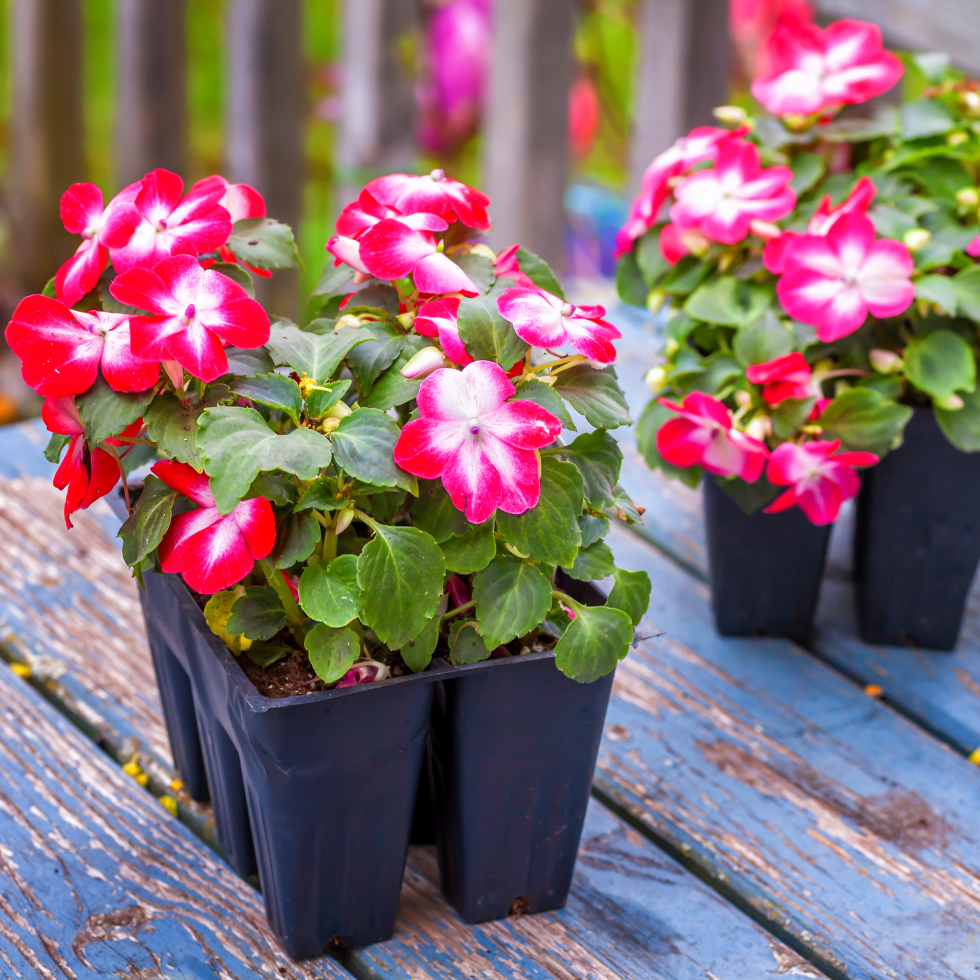
Balsam, also known as Gulmehndi in India, is a vibrant, summer-flowering plant that thrives during the monsoon season. Belonging to the Impatiens family, Balsam produces stunning cup-shaped flowers in shades of pink, purple, red, white, and orange. This annual flowering plant is perfect for garden beds, pots, and even balconies, offering a lush, colorful display.
Balsam plants are known for their self-seeding nature, meaning they regrow naturally every year with minimal effort. The flowers are soft, delicate, and slightly ruffled, blooming in clusters among lush green foliage. Traditionally, the plant has been used in Ayurvedic medicine for its healing properties, particularly for treating skin issues and minor wounds.
Why Choose Balsam?
🌞 Thrives in Warm & Humid Weather – Loves Indian summers and monsoons.
🌼 Blooms in Multiple Colors – Available in pink, purple, red, white, and orange hues.
🌿 Self-Seeding Plant – Comes back every year with little maintenance.
🐝 Attracts Bees & Butterflies – Helps promote pollination and biodiversity.
🏡 Perfect for Pots & Garden Beds – A great choice for small gardens and balconies.
🩺 Medicinal Properties – Used in traditional medicine for skin ailments and pain relief.
Growing Tips for Balsam
✅ Sunlight – Prefers partial shade to full sun (about 4-6 hours of sunlight daily).
✅ Soil – Well-draining, nutrient-rich soil with good moisture retention.
✅ Watering – Keep the soil consistently moist but avoid waterlogging.
✅ Fertilization – Apply an organic fertilizer or compost every 2-3 weeks for healthy growth.
✅ Pruning – Deadhead wilted flowers to encourage more blooms.
✅ Pest Control – Generally resistant to pests but may attract aphids; use neem spray if necessary.
Benefits of Growing Balsam
✔ Adds Instant Color to Gardens – Perfect for a lush, floral display.
✔ Great for Compact Spaces – Grows well in pots, flower beds, and hanging baskets.
✔ Low Maintenance & Self-Seeding – Requires minimal care and regrows on its own.
✔ Natural Skin Remedy – Used in Ayurveda for treating wounds and infections.
✔ Fast-Growing Annual – Blooms quickly and lasts for an extended period.
Fill Your Garden with Balsam’s Beauty!
Add this colorful, easy-growing flower to your space and enjoy nature’s charm! 🌸✨
🌿 Buy Balsam Seeds to Grow Your Own Flowers!
8. Zinnia – Beautiful Summer Bloomer
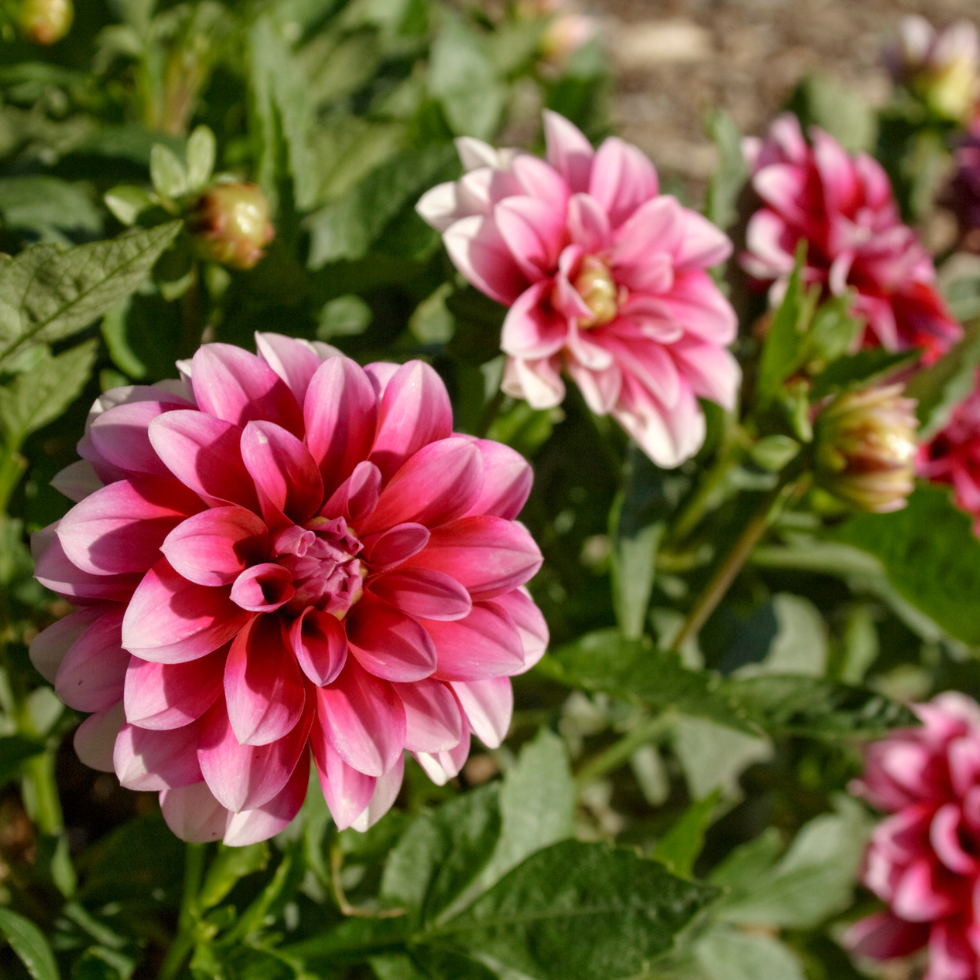
Zinnia is one of the easiest and most rewarding summer flowers to grow, making it a favorite among Indian gardeners. With its bright, daisy-like flowers in a variety of colors, including red, pink, orange, yellow, white, and purple, Zinnia adds a cheerful touch to any garden.
This heat-loving annual is known for its long-lasting blooms and ability to thrive even in hot, dry conditions. Zinnias bloom profusely throughout summer and continue until early winter, providing a vibrant display for an extended period. Their butterfly-attracting nature makes them an excellent choice for pollinator gardens, bringing life and movement to outdoor spaces.
With their easy-to-grow nature, Zinnias are perfect for beginners. Whether planted in flower beds, borders, pots, or as cut flowers for indoor decoration, Zinnias never fail to impress!
Why Choose Zinnia?
🌞 Thrives in Indian Summers – Heat and drought-resistant, perfect for warm climates.
🌸 Blooms in a Variety of Colors – Available in red, pink, yellow, white, orange, and more!
🦋 Attracts Butterflies & Bees – Encourages natural pollination in your garden.
🏡 Perfect for Pots & Garden Beds – Versatile and easy to grow in any space.
🌱 Fast-Growing & Low Maintenance – Requires minimal care and grows quickly.
💐 Great for Cut Flowers – Makes stunning bouquets and floral arrangements.
Growing Tips for Zinnia
✅ Sunlight – Requires full sun exposure (at least 6-8 hours daily).
✅ Soil – Prefers well-draining, fertile soil with good organic matter.
✅ Watering – Water moderately, allowing the soil to dry between watering.
✅ Fertilization – Use a balanced fertilizer every 3-4 weeks for continuous blooms.
✅ Pruning – Deadhead (remove spent flowers) regularly to encourage new blooms.
✅ Pest Control – Watch out for aphids and powdery mildew; use neem oil for protection.
Benefits of Growing Zinnia
✔ Brightens Your Garden – A pop of color that lasts all summer long.
✔ Easy to Grow from Seeds – Ideal for beginner gardeners.
✔ Low Water Requirement – Perfect for water-conscious gardening.
✔ Air-Purifying Properties – Helps improve air quality.
✔ Great for Pollinators – Supports bees and butterflies, helping biodiversity.
Add a Splash of Color with Zinnias!
Bring home these bold and beautiful flowers to enhance your garden with vibrant hues! 🌸✨
9. Hydrangea macrophylla
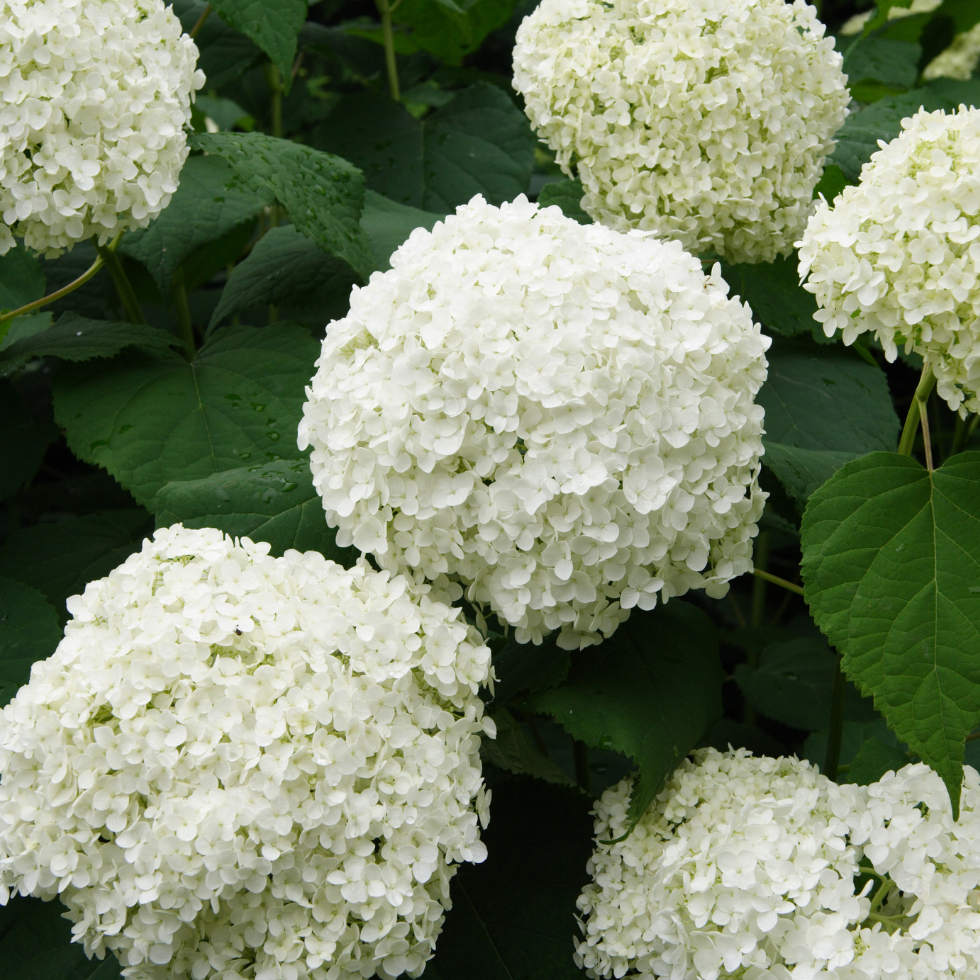
Hydrangea macrophylla, commonly known as Bigleaf Hydrangea, is a breathtaking flowering shrub that transforms any garden into a vibrant paradise. Known for its large, globe-shaped flower clusters, Hydrangea blooms in stunning shades of blue, pink, purple, and white, depending on the soil’s pH.
This deciduous shrub is ideal for Indian summers, especially in regions with moderate to high humidity. With lush green foliage and abundant blossoms, Hydrangea macrophylla adds an elegant charm to balconies, gardens, and landscape designs. Whether used as a hedge, container plant, or centerpiece, it never fails to steal the spotlight.
Why Choose Hydrangea macrophylla?
💙 Unique Color-Changing Flowers – The bloom color shifts based on soil pH (acidic soil = blue, alkaline soil = pink).
🌸 Large, Lush Blooms – Produces dense, vibrant flower clusters that last for months.
🌿 Perfect for Partial Shade – Thrives in areas with indirect sunlight, making it ideal for shaded gardens.
🏡 Great for Containers & Borders – Beautiful as a potted plant or garden hedge.
💦 Loves Humid Climates – Flourishes in warm, tropical conditions with regular watering.
🦋 Attracts Pollinators – Invites bees and butterflies, supporting garden biodiversity.
Growing Tips for Hydrangea macrophylla
✅ Sunlight – Prefers morning sunlight with partial shade in the afternoon.
✅ Soil – Moist, well-draining soil rich in organic matter.
✅ Watering – Requires consistent moisture; water deeply 2-3 times a week.
✅ Fertilization – Apply a phosphorus-rich fertilizer for enhanced blooming.
✅ Pruning – Trim after flowering to encourage fresh blooms the next season.
✅ pH Adjustment – Add aluminum sulfate for blue flowers or lime for pink flowers.
Benefits of Growing Hydrangea macrophylla
✔ Adds Elegance to Any Space – A luxurious flower for gardens, patios, and landscapes.
✔ Great for Floral Arrangements – Ideal for fresh and dried flower decorations.
✔ Air-Purifying Qualities – Helps improve air quality around your home.
✔ Adaptable & Long-Lasting – With proper care, blooms stay fresh for weeks.
✔ Symbolizes Grace & Abundance – A meaningful flower for gifting and decoration.
Enhance Your Garden with Hydrangeas!
Transform your space with the majestic beauty of Hydrangea macrophylla. Order yours today! 🌸💙✨
10. Adenium – The Desert Rose
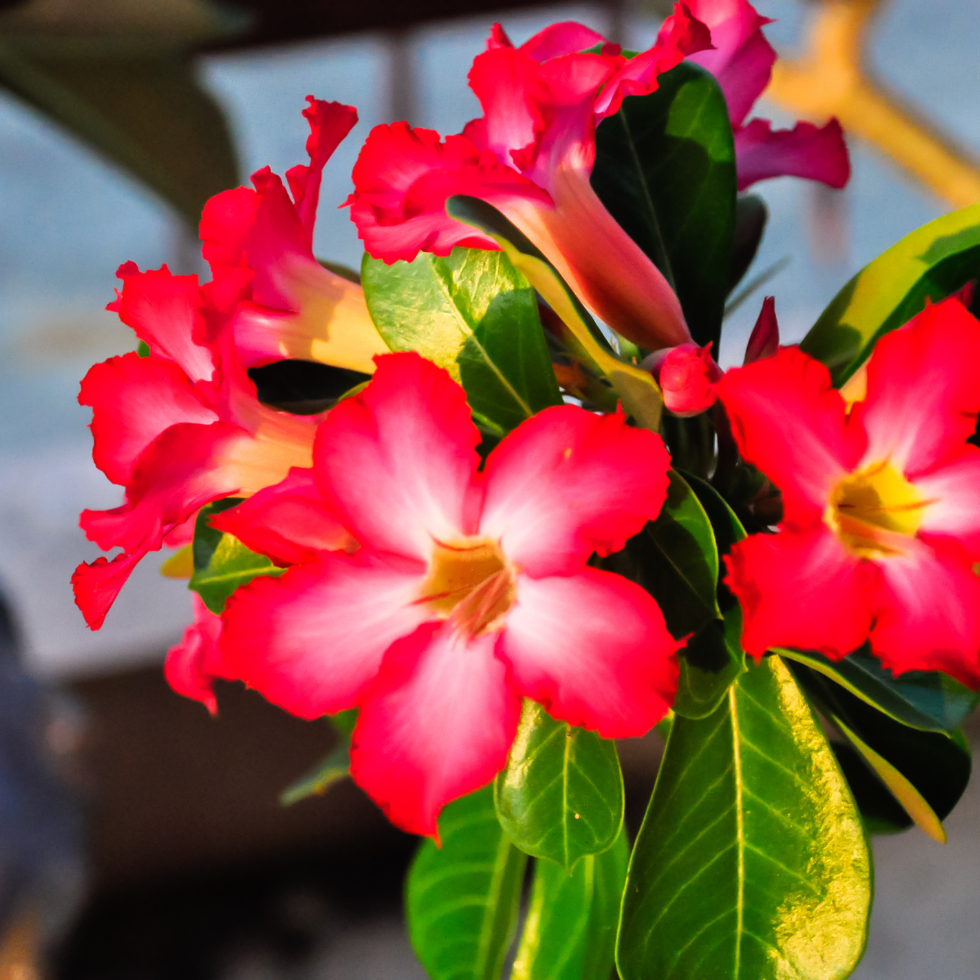
Adenium, commonly known as the Desert Rose, is a striking flowering succulent that thrives in warm and dry climates. Native to Africa and the Middle East, this low-maintenance, drought-resistant plant is perfect for Indian summers.
Adenium is loved for its unique swollen trunk (caudex) and stunning trumpet-shaped flowers, which bloom in vibrant shades of pink, red, white, and even bi-colored patterns. This slow-growing plant is ideal for bonsai lovers due to its sculptural growth pattern and ability to survive with minimal care. Whether grown in pots, rock gardens, or as a bonsai masterpiece, Adenium is an excellent addition to any indoor or outdoor space.
Why Choose Adenium?
🌞 Thrives in Hot, Dry Climates – Perfect for Indian summers and drought-prone areas.
🌺 Blooms Year-Round in Warm Conditions – Stunning flowers in multiple shades.
🌵 Low Maintenance & Drought-Resistant – Requires very little water.
🏡 Ideal for Indoor & Outdoor Spaces – Great for pots, terraces, and balconies.
🌳 Perfect for Bonsai Lovers – Forms a beautiful, artistic caudex.
🐝 Attracts Pollinators – Loved by bees and butterflies.
Growing Tips for Adenium
✅ Sunlight – Needs full sun exposure (at least 5-6 hours daily).
✅ Soil – Well-draining, sandy, or cactus potting mix works best.
✅ Watering – Water once a week in summer and once every two weeks in winter.
✅ Fertilization – Feed with a balanced liquid fertilizer once a month during the growing season.
✅ Pruning – Trim branches for better shape and more blooms.
✅ Pot Selection – Use a well-draining pot with good airflow around roots.
Benefits of Growing Adenium
✔ Perfect for Low-Water Gardens – A top choice for water-saving gardening.
✔ Adds a Tropical Look to Your Home – A visually striking ornamental plant.
✔ Air-Purifying Qualities – Helps remove toxins and improves air quality.
✔ Bonsai-Friendly – Develops artistic, twisted trunks over time.
✔ Long-Lasting Blooms – Produces flowers for extended periods under the right care.
Bring Home the Exotic Beauty of Adenium!
Enhance your garden with Adenium’s sculptural charm and vibrant flowers. Order now! 🌺✨

